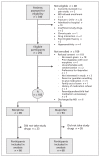Oral administration of morphine versus ibuprofen to manage postfracture pain in children: a randomized trial
- PMID: 25349008
- PMCID: PMC4259768
- DOI: 10.1503/cmaj.140907
Oral administration of morphine versus ibuprofen to manage postfracture pain in children: a randomized trial
Abstract
Background: Recent warnings from Health Canada regarding codeine for children have led to increased use of nonsteroidal anti-inflammatory drugs and morphine for common injuries such as fractures. Our objective was to determine whether morphine administered orally has superior efficacy to ibuprofen in fracture-related pain.
Methods: We used a parallel group, randomized, blinded superiority design. Children who presented to the emergency department with an uncomplicated extremity fracture were randomly assigned to receive either morphine (0.5 mg/kg orally) or ibuprofen (10 mg/kg) for 24 hours after discharge. Our primary outcome was the change in pain score using the Faces Pain Scale - Revised (FPS-R). Participants were asked to record pain scores immediately before and 30 minutes after receiving each dose.
Results: We analyzed data from 66 participants in the morphine group and 68 participants in the ibuprofen group. For both morphine and ibuprofen, we found a reduction in pain scores (mean pre-post difference ± standard deviation for dose 1: morphine 1.5 ± 1.2, ibuprofen 1.3 ± 1.0, between-group difference [δ] 0.2 [95% confidence interval (CI) -0.2 to 0.6]; dose 2: morphine 1.3 ± 1.3, ibuprofen 1.3 ± 0.9, δ 0 [95% CI -0.4 to 0.4]; dose 3: morphine 1.3 ± 1.4, ibuprofen 1.4 ± 1.1, δ -0.1 [95% CI -0.7 to 0.4]; and dose 4: morphine 1.5 ± 1.4, ibuprofen 1.1 ± 1.2, δ 0.4 [95% CI -0.2 to 1.1]). We found no significant differences in the change in pain scores between morphine and ibuprofen between groups at any of the 4 time points (p = 0.6). Participants in the morphine group had significantly more adverse effects than those in the ibuprofen group (56.1% v. 30.9%, p < 0.01).
Interpretation: We found no significant difference in analgesic efficacy between orally administered morphine and ibuprofen. However, morphine was associated with a significantly greater number of adverse effects. Our results suggest that ibuprofen remains safe and effective for outpatient pain management in children with uncomplicated fractures.
Trial registration: ClinicalTrials.gov, no. NCT01690780.
© 2014 Canadian Medical Association or its licensors.
Figures
Comment in
-
Postfracture pain in children can be adequately managed with ibuprofen.Evid Based Med. 2015 Jun;20(3):105. doi: 10.1136/ebmed-2015-110178. Epub 2015 Mar 11. Evid Based Med. 2015. PMID: 25761369 No abstract available.
References
-
- Friedland LR, Pancioli AM, Duncan KM. Pediatric emergency department analgesic practice. Pediatr Emerg Care 1997;13:103–6. - PubMed
-
- Todd KH, Ducharme J, Choiniere M, et al. Pain in the emergency department: results of the pain and emergency medicine initiative (PEMI) multicenter study. J Pain 2007;8:460–6. - PubMed
-
- Wilson JE, Pendleton JM. Oligoanalgesia in the emergency department. Am J Emerg Med 1989;7:620–3. - PubMed
-
- Brown JC, Klein EJ, Lewis CW, et al. Emergency department analgesia for fracture pain. Ann Emerg Med 2003;42:197–205. - PubMed
Publication types
MeSH terms
Substances
Associated data
LinkOut - more resources
Full Text Sources
Other Literature Sources
Medical
Miscellaneous

